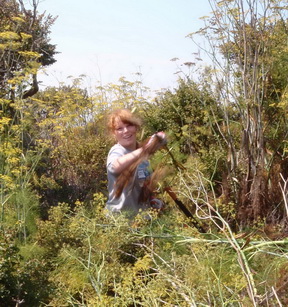
| Friends of Five Creeks |

Above: Near the mouth of Schoolhouse Creek, we kept invasives like this fennel from taking over large areas.. |
Schoolhouse Creek
Schoolhouse Creek is small but historic -- Berkeley's first school was built on its banks, on land donated by Domingo Peralta, son of the area's Spanish land grantee. When Europeans arrived, the creek emptied into the south tip pf a large salt marsh that carried the waters of Schoolhouse, Codornices, and Marin Creeks north behind low dunes and sandy beach. But the beach was mined for construction sand. The creek was put into a pipe that carried sewage west to the Bay, polluting the shoreline. Marsh and shoreline were covered by a garbage dump as the shoreline was filled westward.
Schoolhouse Creek waters are clean again, but the little creek still flows in pipes for most of its course from hills to Bay, emerging only here and there. Friends of Five Creeks' long-term goal is to bring Schoolhouse Creek out of its pipe at its mouth in what is now McLaughlin Eastshore State Park. The resulting tidal channel would enrich the park and also lessen flood danger in West Berkeley.
From 2008 to 2017, F5C volunteers worked to control invasives and make the neglected North Basin Strip, the area from the creek northward, friendly to people and wildlife. We removed invasive, painful yellow star thistle, a forest of invasive, fire-prone French broom, and huge clumps of Pampas grass. We opened "windows" in tall weeds that blocked Bay views and begun planting tough, drought-tolerant natives. Artists discovered the "glass beach" weathering from the World War II area garbage, with a miniature lagoon behind it. We are delighted that this project now has been adopted by board member John Kenny, whose work parties have transformed the shoreline with colorful natives! For information, see "Events of others" in our e-newsletters.
Scroll down for a two-minute slide show of our work at the mouth of Schoolhouse Creek..